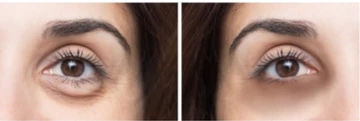Did you know? Pandas who get enough sleep do not have dark circles!
No, that’s about as real as the unicorns.

For anyone who has dealt with under eye dark circles, you know the frustration is real. No amount of sleeping, cold compresses or tea bags over the eyes seem to help. And don’t even get us started on the plethora of over-the-shelf under eye creams.
The issue? Dark Circles under the eyes are an extreme condition and there are no quick fixes. Let’s look at the science and explain what causes dark circles under the eyes and understand why they remain one of the most dreaded conditions that impacts a great number of Indians.
Not all that over-shadows the eyes are Dark Circles!
Surprisingly many people mistake other cosmetic conditions like under eye bags or dermatochalasis with dark circles. Eye bags are due to the prominence of the fat pads which pooch out from behind the eye. Dark circles on the other hand focus on the appearance of pigment or shadow in the areas around the eye.

Moreover, there are Pigmented dark circles and Structural dark circles. The pigmented variety, like the name suggests, are caused by pigments under the eyes, leading to the appearance of a black/bluish tint to the under-eye area. Structural ones on the other hand, are characterized by overall darkness in the under-eye when the eye shape causes a shadowed appearance.
A common, simple test that you can do is the “pinch” test. If you gently pinch the under-eye with two fingers and the dark pigmentation is still there, you likely have dark circles. However, this only checks for pigmented dark circles, and not structural ones. Under eye dark circles are complex. There are many different causes and manifestations that are sometimes hard to diagnose visually. An accurate diagnosis can be extremely valuable to help understand exactly what your dark circles are, what causes them, and how best to treat them.
So, what’s the cause?
The complex nature of dark circles often boils down to three possible causes:

- Vasculature (blood vessels): The skin covering our eyelids is thin and translucent. Its pigmentation depends on the underlying muscle beneath the superficial skin, called the orbicularis oculi muscle. Increased blood flow to this area can lead to swelling and the appearance of a deep violet color, as the breakdown of hemoglobin in the blood can produce these pigments. Usually, if you do the pinch test, the color of the under-eye skin will slightly diffuse out and turn a deeper violet.
- Hyperpigmentation: Hyperpigmentation is another common reason. This can be genetic; Indian skin is known for this type of under-eye hyperpigmentation. Or it can also be acquired over time. Whether it's through sun exposure, fatigue, inflammation, allergies, or as side effects of drugs, the accumulation of melanin pigment can darken the skin under the eyes. In this case, when you do the pinch test, the colour of your under-eyes will often stay the same.
-
Facial & skin structure: Shadowing due to eye structure can also cause the appearance of dark circles. For some people with deep-set eyes, dark circles are part of their facial features. For others, a bulging of the lower eyelid can worsen the shadowed appearance. Sometimes these changes are caused by the loss of skin elasticity, leading to bagginess and more pronounced under eye shadow. Ageing can also reduce the amount of fat present in the skin, causing hollowness and segmentation of the under-eye. Especially in these cases, your dark circles often change in appearance with different lightings, appearing darker when you are in overhead lighti
And the complexity doesn’t stop there- these primary causes often combine and interact, which makes dark circles hard to diagnose and treat. And so, no matter how much you sleep, or put that yet another fancy eye cream you bought from your favorite organic store, sometimes, your under eye dark circles remain your loyal friend- because you haven’t treated the root cause amongst a combination of causes.
So how do you treat these pesky uninvited guests? Stay tuned for our next blog as we discuss the ways to treat under eye dark circles!
References:
Vrcek, I., Ozgur, O., & Nakra, T. (2016). Infraorbital dark circles: a review of the pathogenesis, evaluation and treatment. Journal of cutaneous and aesthetic surgery, 9(2), 65.
Freitag, F. M., & Cestari, T. F. (2007). What causes dark circles under the eyes?. Journal of cosmetic dermatology, 6(3), 211-215.
Roh, M. R., & Chung, K. Y. (2009). Infraorbital dark circles: definition, causes, and treatment options. Dermatologic surgery, 35(8), 1163-1171.







